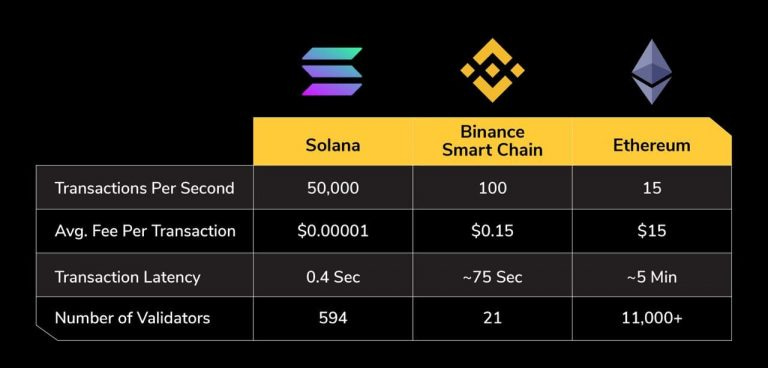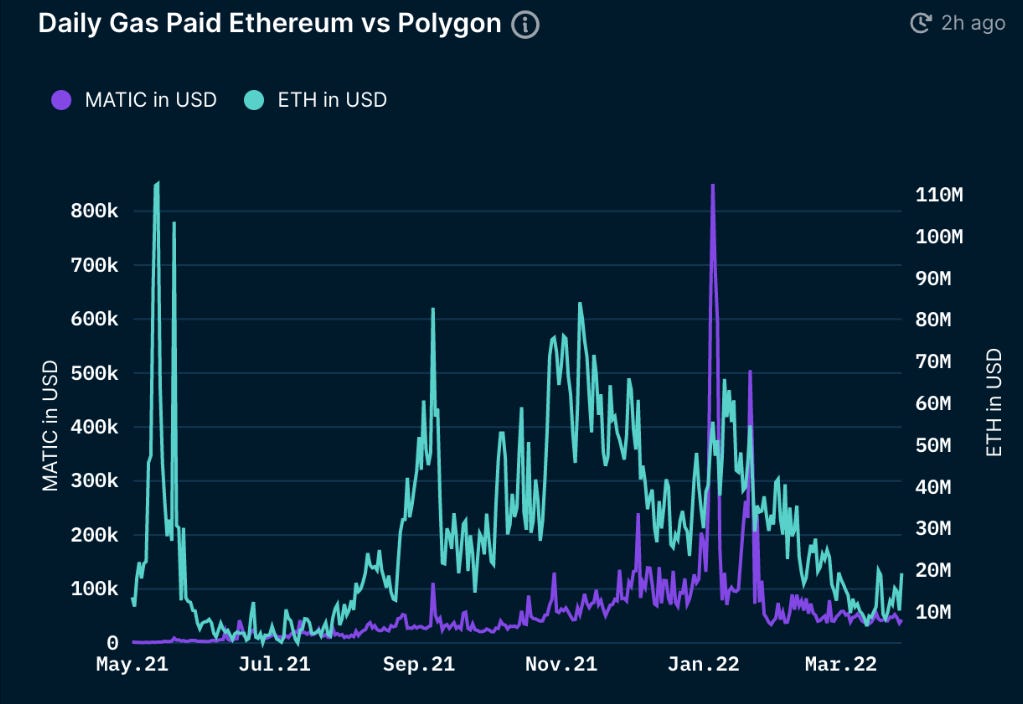Polygon: Scaling Ethereum for Mass Adoption
Polygon is on a mission to become The Internet of Blockchains
In this post, we will discuss:
Ethereum Gas Fees and Decentralization
Polygon MATIC Layer 1 Sidechain
Layer 2 Scaling Solutions (Optimistic vs ZK Rollups)
Tokenomics of Polygon MATIC
High gas fees on Ethereum are a feature rather than a bug. The Ethereum network is optimized for low block spaces, only handling a minimal amount of transactions per second. When anyone tries to settle a transaction through this network, they are essentially bidding to occupy one of these spots. As Ethereum becomes more popular, more people bid against each other, driving gas fees higher over time.
Ethereum does this primarily for 2 reasons. First, decentralization has always been at the core of Ethereum’s mission. Creating more block space would lower fees but become a hindrance for new validators who want to join the network. The cost required to download the massive amount of blocks would only be affordable for so-called “whales”. The second is security. If only a few large players can validate Ethereum, then it introduces the risk of a bad actor negatively impacting the entire ecosystem.
This is both good and bad news. The good news here is that the second-largest crypto by market capitalization is paying a lot of attention to security and decentralization.
However, the bad news is that very few people actually care about these aspects. At the end of the day, individual users simply want the lowest fees possible. So, if Ethereum becomes expensive with more usage, then it can’t ever scale for mass adoption.
This has always been one of the largest challenges for the Ethereum community. Builders on the network have been faced with the dilemma: is it worth compromising security and decentralization for the sake of adoption? Polygon is working towards a solution that attempts to capture and preserve the best of both worlds.
Polygon and Layer 1 Sidechain
Polygon is an Ethereum layer 2 scaling platform that aims to increase the functionality and throughput of Ethereum. The goal of the company is to offer a host of multichain services to help scale blockchain networks to the next level.
When most people think of Polygon, they think of the Polygon Proof of Stake (PoS) sidechain. This chain uses its own set of validators and uses a native token called $MATIC. EVM compatibility is at the core of the sidechain’s functionality. It allows any developer to easily migrate apps from Ethereum to Polygon and take advantage of the lower fees.
An important consideration here is that the sidechain is still considered a layer-1 network that runs in parallel to Ethereum. One analogy to help understand it could be to think of Polygon as an express train that runs alongside Ethereum’s local subway. The Polygon network makes fewer stops on the way but still takes passengers to the ultimate destination. This way, they are able to accelerate transactions and subsequently, lower fees.
As you can see, the number of transactions on Polygon has absolutely exploded in the past year. This can be attributed to the popularity of crypto and Ethereum, which has pushed gas fees higher during this period.
While the layer 1 sidechain is already reaching impressive heights, it is only the first in the set of products that Polygon has planned for its roadmap. The company is now focusing efforts on layer 2 solutions.
Layer 2 and ZK Roll-up
Sidechains provide lower fees but still suffer from issues related to security. Since the PoS chain of Polygon is using its own validators, the network is nowhere near as safe as Ethereum itself. Layer 2s emerged as a more optimal solution - a way to lower transaction costs while leveraging Ethereum’s security benefits.
One way to think of layer 2s is in the context of a nation-state. If Ethereum is a nation, then layer 2 networks are just states within it. New York or California, for example, are able to take advantage of the fact that the U.S has the largest military budget in the world. Similarly, layer 2s build functionality on Ethereum without losing the security that the network has already built-in.
There are primarily 2 ways to scale a blockchain using this method. First, since validating transactions on Ethereum increases the cost of transactions, you can assume that every transaction is already correct and let them pass through. Then you go back and let verifiers check them at a later point in time on the mainnet itself. This is what is known as an Optimistic Rollup - you are optimistic in assuming that every transaction will be fraud-proof.
The second is what is known as ZK rollups, and this is primarily what Polygon is planning on building. Zero-Knowledge, or ZK, rollups batch transactions together and pass them on to the mainnet of Ethereum. This way, validators can confirm large number of transactions at once without having particular knowledge of any individual transaction.
Polygon is building six different ZK solutions, including 3 direct ZK rollups (Hermez, Miden, and Zero), 1 optimistic rollup with ZK technology (Nightfall), and 2 ZK infrastructure products (Avail and Edge). More recently, Polygon has also announced the introduction of supernets where developers can easily build decentralized apps on Polygon with minimal operational costs.
Not surprisingly, Polygon’s ecosystem is now massive and growing faster than ever before. The number of unique Polygon addresses and total transaction size on Polygon has also been steadily increasing in the past few months. TVL, or Total Value Locked, on Polygon, has exponentially increased in the past year, now sitting at ~$3.5 billion.
Stress in the System
Like any other crypto project, Polygon has faced its share of difficulties and challenges on its way here. One particular sign of stress was related to an NFT game named “Sunflower Farmers”. This “play-to-earn” project incentivized users to spam the network with activity, leading to congestion in Polygon’s network. At its peak, Sunflower Farmers accounted for ~50% of the gas fees on Polygon.
The chart below shows a clear spike in prices on Polygon, mostly attributable to just one application.
Towards the tail end of 2021, there was also a notorious hack on the network where a vulnerability was used to steal ~800K MATIC tokens. The company acted quickly to fix the bug and confirmed that they will be bearing the cost of the theft.
Tokenomics
The native token MATIC primarily serves two purposes for the network:
Fees: Users use MATIC to pay gas fees for transacting on the network
Staking: Users stake MATIC to participate as validators of the network and earn staking rewards
The initial token distribution of MATIC was as follows:
Private Sale: 3.8%
Binance Launchpad Sale (IEO): 19% of total supply cap
Team: 16%
Advisors: 4%
Network Operations: 12%
Foundation: 21.86%
Ecosystem: 23.33%
MATIC has a total supply cap of 10 billion, with ~8 billion of it already in circulation. The price of each individual token today is $0.63 with a total market capitalization of roughly $5 billion.
The remaining supply schedule of the token is as follows:
On January 18 of this year, Polygon announced that they will be implementing EIP-1559 as a way to align themselves further with Ethereum. As the usage of the Polygon chain increases, base fees will be used to burn and contract the supply of MATIC.
While this will reduce staking rewards, it will benefit the ecosystem as a whole by putting deflationary pressure on the token. According to most simulations, the annual burnt MATIC will be about 0.27% of the total supply. This is bullish for the token price, especially if transaction volume picks up on the network
Conclusion
With an ambitious goal of becoming an internet of blockchains, Polygon is moving ahead at full speed. The company is aligned with the overall industry’s ethos of decentralization and the choice to scale Ethereum fully reflects its values. This is a project worth paying attention to.
To learn more about Polygon, visit their website here and follow them on Twitter to show your support.










